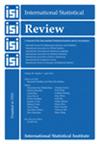调查抽样理论对构建有效临床试验的启示
IF 1.8
3区 数学
Q1 STATISTICS & PROBABILITY
引用次数: 2
摘要
例如,为了实现临床试验,组织实验设计至关重要。通常需要平衡设计,以便在测试组和对照组中协变的平均值大致相同。在调查抽样理论中,平衡抽样和校准是提高估计精度的两种技术。在本文中,我们展示了这两个领域之间的联系。我们首先评估最小二乘估计量和差分估计量的平衡设计和简单随机抽样之间的精度增益。为了平衡设计,我们比较了重新绘制技术和立方体方法。我们提出了一种新的方法,特别有效,它将立方体方法与多元匹配相结合。为了评估不同的方法,进行了一组模拟。即使设计几乎是平衡的,也会显示出校准的兴趣。因此,调查统计学家使用的工具可以用于实验设计和临床试验。本文章由计算机程序翻译,如有差异,请以英文原文为准。
Some Solutions Inspired by Survey Sampling Theory to Build Effective Clinical Trials
The organisation of a design of experiments, for example, for the realisation of a clinical trial, is crucial. It is often desirable to balance designs so that the means of the covariates are approximately the same in the test and control groups. In survey sampling theory, balanced sampling and calibration are two techniques that improve the precision of estimates. In this paper, we show the links between the two areas. We begin by assessing the gain in precision between a balanced design and a simple random sampling for the least squares estimators and the estimator by differences. We compare rerandomisation techniques and the cube method in order to balance the design. We propose a new method, particularly efficient, which combines the cube method with multivariate matching. A set of simulations is carried out in order to evaluate the different methods. The interest of the calibration is shown even if the design is almost balanced. It is thus shown that tools used by survey statisticians can be useful for experimental designs and clinical trials.
求助全文
通过发布文献求助,成功后即可免费获取论文全文。
去求助
来源期刊

International Statistical Review
数学-统计学与概率论
CiteScore
4.30
自引率
5.00%
发文量
52
审稿时长
>12 weeks
期刊介绍:
International Statistical Review is the flagship journal of the International Statistical Institute (ISI) and of its family of Associations. It publishes papers of broad and general interest in statistics and probability. The term Review is to be interpreted broadly. The types of papers that are suitable for publication include (but are not limited to) the following: reviews/surveys of significant developments in theory, methodology, statistical computing and graphics, statistical education, and application areas; tutorials on important topics; expository papers on emerging areas of research or application; papers describing new developments and/or challenges in relevant areas; papers addressing foundational issues; papers on the history of statistics and probability; white papers on topics of importance to the profession or society; and historical assessment of seminal papers in the field and their impact.
 求助内容:
求助内容: 应助结果提醒方式:
应助结果提醒方式:


